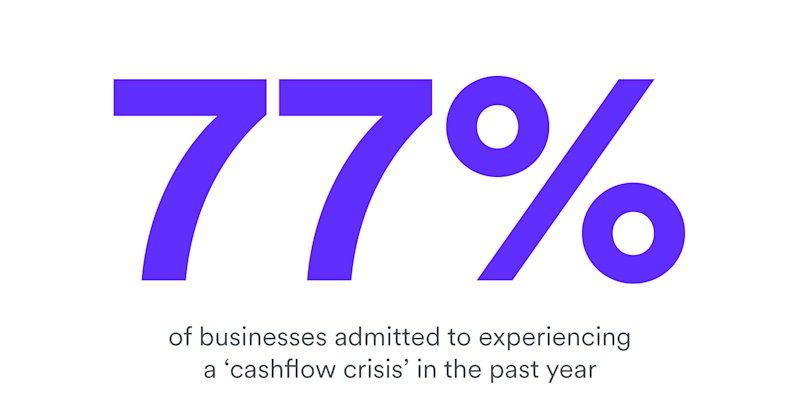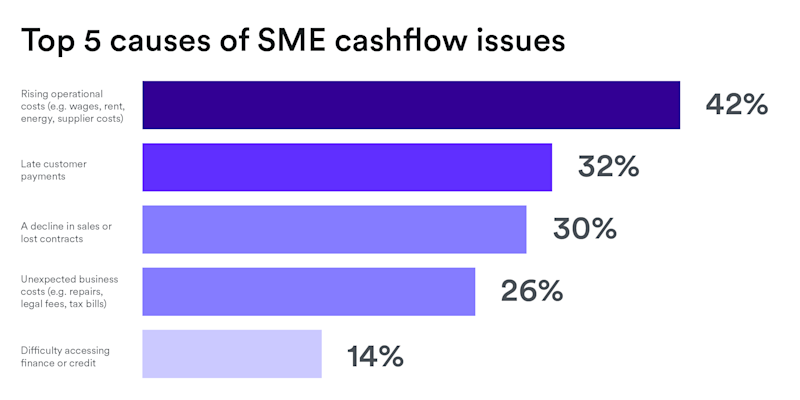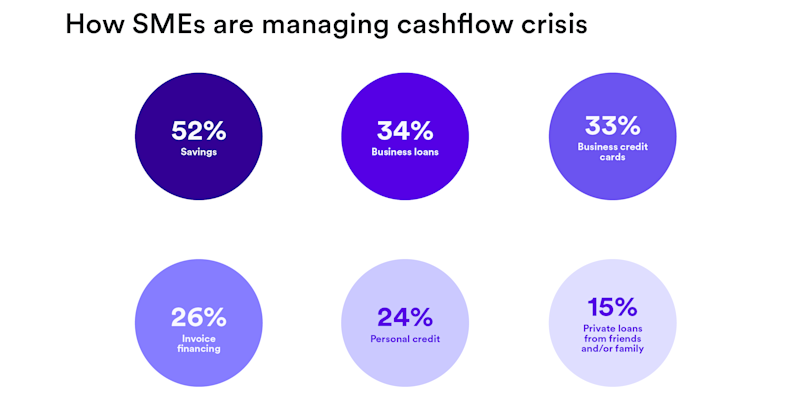2025 Report: How late payments are costing businesses more than you think

Airwallex Editorial Team

For small business owners, late customer payments have become more than just a routine nuisance; they've become a systemic issue that chips away at the cash flow essential for running a business.
Small businesses represent 98% of all Australian companies and contribute to 42% of national employment*, according to reports from the Australian government. Therefore, any issue affecting them inevitably has a ripple effect on the broader economy.
When businesses face cash shortages, they often resort to alternative means to keep operations going, often stretching their already thin cashflow chains to breaking point. Beyond the financial strain, these ongoing delays can take a toll on the team’s morale, inhibit growth opportunities and create a cycle of administrative overload.
Additionally, these late payments make it harder to monitor and manage expenses, again disrupting the cashflow chain and squeezing the profit margins.
To understand the scope of this issue and spotlight its everyday impact on Australian businesses, we conducted an in-depth survey exploring the current state of cashflow among small and medium enterprises.
In this article, we’ll share our findings, identify the leading causes behind a cashflow crisis and reveal how businesses are adapting to these challenges to survive in today’s landscape.
About the research
We surveyed 500 SME owners and decision-makers across Australia to better understand the financial pressures they face, particularly around cashflow and how they’re navigating a landscape that’s increasingly being crippled by delayed payments.

What are the main reasons for a cashflow crisis among small businesses?
A consistent cashflow is the backbone of any business. When a company works to produce a product or service, it expects timely payment in return. That income is then used to pay suppliers, staff and operational costs. However, when payments are delayed or unexpected costs arise, the entire chain gets disrupted, forcing business owners to divert funds, delay investments or seek external financing just to keep the business running.
Of those surveyed, 77% of SME business owners and leaders admitted to experiencing a ‘cashflow crisis,’ with 42% of those attributing this difficulty to a rise in operational costs such as wages, rent, energy bills and supplier fees.
Late customer payments were reported by nearly a third (32%) of respondents as a key contributor to their cashflow issues, followed by 30% who said that a decline in sales or lost contracts has made them experience a cashflow shortage in running their businesses.

How are SME owners managing the cashflow shortfalls?
When it comes to managing these cashflow shortfalls, businesses are turning to methods that may get them out of their current situation but are unsustainable in the longer run. Worryingly, over half (52%) reported dipping into their savings to stay running, indicating how personal and business finances are increasingly being intertwined.
Over a third (34%) of businesses said they’ve taken out business loans to cover gaps, while 33% are relying on business credit cards, often with high interest rates.
Over a quarter (26%) have turned to invoice financing to access cash tied up in unpaid invoices, demonstrating the need to access funds in a hurry. However, the pressure is also being felt on a personal level, with 24% saying they have resorted to personal credit, such as loans or credit cards, and almost 15% of business owners have even borrowed money from friends or family to maintain operations.

How much financial loss are late payments causing the businesses?
Late payments have become a costly issue with businesses having to fill the gaps from their own pockets, often amounting to thousands of dollars each year.
According to the data, the average loss reported due to late payments is AU$2,408 every month – equating to nearly AU$29,000 annually. Worryingly, 84% of Australian SME businesses reported losing up to AU$4,999 on a monthly basis because of delayed invoices, which means a staggering annual loss of almost AU$60,000 for those SME owners.
For businesses with a monthly revenue between AU$50,001 and AU$100,000, the average monthly loss climbs to AU$2,569, while those earning more than AU$250,000 feel the biggest hit with an average loss of AU$3,055 per month.
When it comes to invoices, only 22% of respondents said that all their invoices are paid on time. The rest are regularly chasing payments, with nearly two-thirds (59%) saying up to a quarter of their invoices are paid late and a further 13% reporting delays on up to 50% of their invoices.

What are SMEs doing to tackle the issue?
To manage the growing burden of late payments, SMEs are having to become increasingly proactive. While 14% of respondents said they never have to chase overdue invoices, the vast majority do. Over a third (35%) said they occasionally need to chase a few overdue invoices each year and one-in-five (20%) deal with at least one late payment every month.
Time is another hidden cost. On average, SMEs spend almost four hours per month chasing payments. The majority of respondents (54%) reported spending one to five hours monthly on this task, while nearly one-in-five (19%) said it takes them six–10 hours per month.
When it comes to the strategies businesses use to recover overdue payments, the most common approach is a polite but persistent follow-up, with nearly three-in-five (59%) saying they send reminders and follow-up with calls or emails, making this the most popular late payment chasing method. Meanwhile, 39% offer payment plans or revised terms and almost a third (32%) enforce late payment fees or interest charges to encourage faster settlement. More serious action is also taken in some cases, with 15% resorting to legal action and 17% using collections agencies. Worryingly, over one in 10 (12%) end up writing off unpaid invoices, while just 6% admit they don’t have a formal process in place at all.

How Airwallex offers a solution to solve the cashflow crisis due to late payments?
For SMEs struggling with late payments and tight cashflow, Airwallex offers a practical solution. By providing multi-currency accounts, Airwallex enables businesses to receive and make payments in local currencies, helping them sidestep FX fluctuations and reduce unnecessary conversion fees. This is especially beneficial for companies with international clients or suppliers, allowing them to maintain smoother cashflow across borders.
In addition, Airwallex’s real-time expense tracking, borderless payment capabilities, and automated reconciliation tools help finance teams stay in control, freeing up time spent chasing paperwork and improving visibility over outgoing payments. For SMEs navigating delayed income, having a centralised platform to manage spend and pay suppliers efficiently can make a meaningful difference in preserving margins and keeping operations running smoothly.
You can see our full range of business payment solutions here.
Methodology
The research was conducted by Censuswide, among a sample of 500 SME business owners/leaders (aged 18+) in Australia. The data was collected between 23.07.2025-29.07.2025.
Censuswide abides by and employs members of the Market Research Society and follows the MRS code of conduct and ESOMAR principles. Censuswide is also a member of the British Polling Council.
Sources
* https://www.asbfeo.gov.au/small-business-data-portal/contribution-australian-employment
View this article in another region:Hong Kong SAR - EnglishHong Kong SAR - 繁體中文United Kingdom

Airwallex Editorial Team
Airwallex’s Editorial Team is a global collective of business finance and fintech writers based in Australia, Asia, North America, and Europe. With deep expertise spanning finance, technology, payments, startups, and SMEs, the team collaborates closely with experts, including the Airwallex Product team and industry leaders to produce this content.
Posted in:
Finance operationsShare
- About the research
- What are the main reasons for a cashflow crisis among small businesses?
- How are SME owners managing the cashflow shortfalls?
- How much financial loss are late payments causing the businesses?
- What are SMEs doing to tackle the issue?
- How Airwallex offers a solution to solve the cashflow crisis due to late payments?


